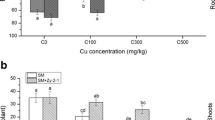Abstract
Nineteen strains of root nodule bacteria were grown under various iron regimes (0.1, 1.0 and 20 μM added iron) and tested for catechol and hydroxamate siderophore production and the excretion of malate and citrate. The growth response of the strains to iron differed markedly. For 12 strains (Bradyrhizobium strains NC92B and 32H1, B. japonicum USDA110 and CB1809, B. lupini WU8, cowpea Rhizobium NGR234, Rhizobium meliloti strains U45 and CC169, Rhizobium leguminosarum bv viciae WU235 and Rhizobium leguminosarum bv trifolii strains TA1, T1 and WU95) the mean generation time showed no variation with the 200-fold increase in iron concentration. In contrast, in Bradyrhizobium strains NC921, CB756 and TAL1000, B. japonicum strain 61A76 and R. leguminosarum bv viciae MNF300 there was a 2–5 fold decrease in growth rate at low iron. R. meliloti strains WSM419 and WSM540 showed decreased growth at high iron.
All strains of root nodule bacteria tested gave a positive CAS (chrome azurol S) assay for siderophore production. No catechol-type siderophores were found in any strain, and only R. leguminosarum bv trifolii T1 and bv viciae WU235 produced hydroxamate under low iron (0.1 and 1.0 μM added iron).
Malate was excreted by all strains grown under all iron regimes. Citrate was excreted by B. japonicum USDA110 and B. lupini WU8 in all iron concentrations, while Bradyrhizobium TAL1000, R. leguminosarum bv viciae MNF300 and B. japonicum 61A76 only produced citrate under low iron (0.1 and/or 1.0 μM added iron) during the stationary phase of growth.
Similar content being viewed by others
Abbreviations
- CAS:
-
chrome azurol S
- HDTMA:
-
hexadecyltrime-thylammonium bromide
References
Ames-Gottfred NP, Christie BR, Jordan DC (1989) Use of chrome azurol S agar plate technique to differentiate strains and field isolates of Rhizobium leguminosarum biovar trifolii. Appl Environ Microbiol 55: 707–710
Arnow LE (1937) Colorimetric determination of the components of 3,4-dihydroxyphenylalanine-tyrosine mixtures. J Biol Chem 118: 531–537
Atkin CL, Phaff H, Neilands JB (1970) Rhodotorulic acid from species of Leucosporidium, Rhodosporidium, Rhodotorula, Sporidiobolus and Sporobolmyces and a new alanine-containing ferrichrome from Cryptococcus melibiosum. J Bacteriol 103: 722–733
Bagg A, Neilands JB (1987) Molecular mechanism of regulation of siderophore-mediated iron assimilation. Microbiol Rev 51: 509–518
Bernt E, Bergmeyer HU (1974) l-Glutamate UV-assay with glutamate dehydrogenase and NAD. In: Bergmeyer MV ed. Methods of enzymatic analysis. Academic Press, New York, pp 1704–1708
Bosch I, Meidl EJ, Plessner O, Guerinot ML (1988) Iron uptake and metabolism in the Bradyrhizobium-soybean symbiosis. In: Bothe H, Bruijn FJde, Newton WE (eds) Nitrogen fixation hundred years after. Fischer, Stuttgart p 652
Bradford MM (1976) A rapid and sensitive method for the quantitation of microgram quantities of protein utilizing the principle of protein-dye binding. Anal Biochem 72: 248–254
Brown CM, Dilworth MJ, (1975) Ammonia assimilation by Rhizobium cultures and bacteroids. J Gen Microbiol 86: 39–48
Carson KC, Dilworth MJ, Glenn AR (1991) Siderophore production and iron transport in Rhizobium leguminosarum bv. viciae MNF710. J Plant Nutr (in press)
Dagley S (1974) Citrate UV spectrophotometric determination. In: Bergmeyer MV (ed) Methods of enzymatic analysis. Academic Press, New York, pp 1562–1569
Gillam AH, Lewis AG, Anderson RJ (1981) Quantitative determination of hydroxamic acids. Anal Chem 53: 841–844
Guerinot ML (1991) Iron uptake and metabolism in the rhizobia/legume sumbioses. Plant Soil 130: 199–209
Guerinot ML, Meidl EJ, Plessner O (1990) Citrate as a siderophore in Bradyrhizobium japonicum. J Bacteriol 172: 3298–3303
Modi M, Shah KS, Modi VV (1985) Isolation and characterisation of catechol-type siderophore from cowpea Rhizobium RA-1. Arch Microbiol 141: 156–158
Mollering H, Gruber W (1966) Determination of citrate with citrate lyase. Anal Biochem 17: 369–376
Nambiar PTC, Sivaramakrishnan S (1987) Detection and assay of siderophores in cowpea rhizobia (Bradyrhizobium) using radioactive Fe (59Fe). Appl Micro Lett 4: 37–40
Neilands JB (1981) Microbial iron compounds. Annu Rev Microbiol 50: 715–731
Ncilands JB (1984) Methodology of siderophores. Struct Bond (Berl) 58: 1–24
O'Hara GW, Dilworth MJ, Bookerd N, Parkpian P (1988a) Iron deficiency specifically limits nodule development in peanut inoculated with Bradyrhizobium sp. New Phytol 108: 51–57
O'Hara GW, Hartzook A, Bell RW, Loneragan JF (1988b) Response to Bradyrhizobium strain of peanut cultivars grown under iron stress. J Plant Nutr 11: 6–11
Patel HN, Chakraborty RN, Desai SB (1988) Isolation and partial characterization of phenolate siderophore from Rhizobium leguminosarum IARI102. FEMS Microbiol Lett 56: 131–134
Postgate JR (1982) The fundamentals of nitrogen fixation. Cambridge University Press, Cambridge
Reigh G, O'Connell M (1988) Siderophore production is strain specific in Rhizobium. In: Bothe H, Bruijn FJde, Newton WE (eds) Nitrogen fixation hundred years after. Fischer, Stuttgart, p 826
Rioux CR, Jordan DC, Rattray JBM (1986a) Iron requirement of Rhizobium leguminosarum and secretion of anthranilic acid during growth on an iron-deficient medium. Arch Biochem Biophys 248: 175–182
Rioux CR, Jordan DC, Rattray JBM (1986b) Anthranilate-promoted iron uptake in Rhizobium leguminosarum. Arch Biochem Biophys 248: 183–189
Schwyn B, Neilands JB (1987) Universal chemical assay for the detection and determination of siderophores. Anal Biochem 160: 47–56
Schwyn B, Neilands JB (1987) Siderophores from agronomically important species of the Rhizobiaceae. Comments Agric Food Chem 1: 95–114
Skorupska A, Derylo M, Lorkiewicz Z (1989) Siderophore production and utilization by Rhizobium trifolii. Biol Metals 2: 45–49
Smith MJ, Neilands JB (1984) Rhizobactin a siderophore from Rhizobium meliloti. J Plant Nutr 7: 449–458
Smith MJ, Shoolery JN, Schwyn B, Holden I, Neilands JB (1985) Rhizobactin, a structurally novel siderophore from Rhizobium meliloti. J Am Chem Soc 107: 1739–1743
Tang C, Robson AD, Dilworth MJ (1990a) The role of iron in nodulation and nitrogen fixation in Lupinus angustifolius L. New Phytol 114: 173–182
Tang C, Robson AD, Dilworth MJ (1990b) A split-root experiment shows that iron is required for nodulation initiation in Lupinus angustifolius L. New Phytol 115: 61–67
Author information
Authors and Affiliations
Rights and permissions
About this article
Cite this article
Carson, K.C., Holliday, S., Glenn, A.R. et al. Siderophore and organic acid production in root nodule bacteria. Arch. Microbiol. 157, 264–271 (1992). https://doi.org/10.1007/BF00245160
Received:
Accepted:
Issue Date:
DOI: https://doi.org/10.1007/BF00245160




